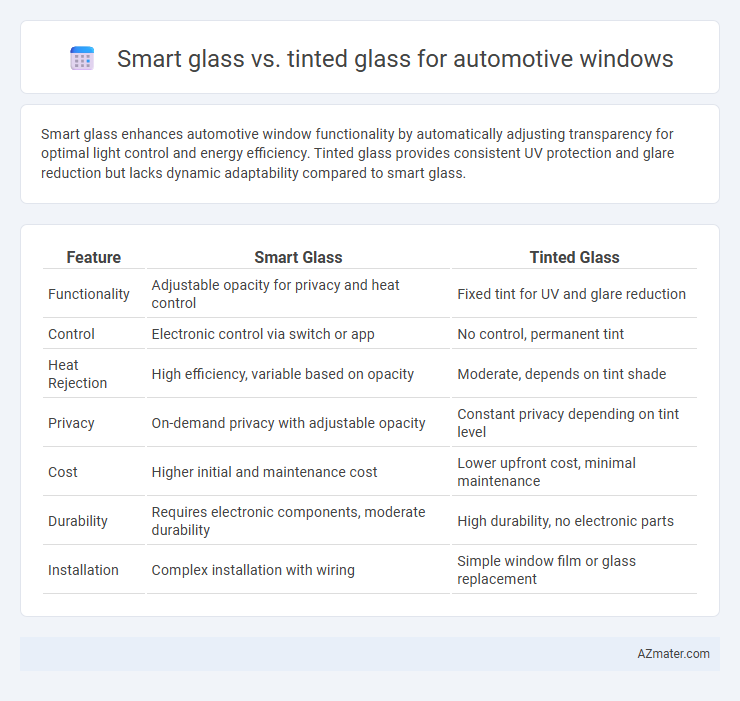Smart glass enhances automotive window functionality by automatically adjusting transparency for optimal light control and energy efficiency. Tinted glass provides consistent UV protection and glare reduction but lacks dynamic adaptability compared to smart glass.
Table of Comparison
| Feature | Smart Glass | Tinted Glass |
|---|---|---|
| Functionality | Adjustable opacity for privacy and heat control | Fixed tint for UV and glare reduction |
| Control | Electronic control via switch or app | No control, permanent tint |
| Heat Rejection | High efficiency, variable based on opacity | Moderate, depends on tint shade |
| Privacy | On-demand privacy with adjustable opacity | Constant privacy depending on tint level |
| Cost | Higher initial and maintenance cost | Lower upfront cost, minimal maintenance |
| Durability | Requires electronic components, moderate durability | High durability, no electronic parts |
| Installation | Complex installation with wiring | Simple window film or glass replacement |
Introduction to Automotive Window Technologies
Smart glass for automotive windows offers adaptive transparency, allowing drivers to control light and heat entering the vehicle through electrochromic or suspended particle devices. Tinted glass provides a fixed level of shading by embedding color or dyes during manufacturing, reducing glare and UV exposure. Advancements in smart glass technology enhance energy efficiency and passenger comfort compared to traditional tinted glazing solutions.
What is Smart Glass?
Smart glass for automotive windows refers to electronically switchable glass that changes its light transmission properties when an electric voltage is applied, enabling instant control over transparency and privacy. Unlike traditional tinted glass, which relies on fixed color or darkness achieved through dyes or films, smart glass utilizes technologies such as electrochromic, photochromic, or suspended particle devices (SPD) to dynamically adjust heat and glare reduction. This functionality improves energy efficiency, enhances passenger comfort, and offers customizable shading options in vehicles.
What is Tinted Glass?
Tinted glass for automotive windows is specially treated with a dye or film to reduce visible light transmission, blocking harmful UV rays and decreasing glare for enhanced driver comfort. This type of glass helps regulate interior temperature by minimizing heat buildup, contributing to energy efficiency and protection of the vehicle's interior materials. Unlike smart glass, tinted glass does not change its opacity or transparency in response to environmental conditions or electrical stimuli.
Key Differences Between Smart Glass and Tinted Glass
Smart glass for automotive windows utilizes electrochromic or photochromic technology to dynamically control light transmission and privacy, whereas tinted glass features a static film or coating that reduces glare and UV exposure. Smart glass offers real-time adjustability and energy efficiency by modulating solar heat gain, while tinted glass primarily provides consistent shading without the ability to change opacity. Maintenance and installation costs tend to be higher for smart glass due to its advanced electronic components, in contrast to the relatively low cost and simpler application process of tinted glass.
Energy Efficiency Comparison
Smart glass for automotive windows significantly outperforms traditional tinted glass in energy efficiency by dynamically controlling solar heat gain and reducing the need for air conditioning. Unlike static tinted glass, smart glass regulates light transmission and heat influx based on environmental conditions, leading to lower cabin temperatures and improved fuel economy. Studies show vehicles equipped with smart glass can achieve up to 30% energy savings compared to those using conventional tinted windows.
Privacy and Security Features
Smart glass offers advanced privacy control by electronically switching between transparent and opaque states, providing instant and customizable privacy compared to tinted glass, which provides a fixed level of opacity. The dynamic nature of smart glass enhances security by preventing visual access to the vehicle's interior on demand, reducing the risk of theft or unauthorized viewing. Tinted glass, while effective at reducing glare and blocking UV rays, lacks the adaptability and precise control over privacy that smart glass technology delivers.
UV and Heat Protection
Smart glass for automotive windows offers advanced UV and heat protection by actively controlling light transmission using electrochromic technology, significantly reducing solar heat gain and blocking up to 99% of harmful ultraviolet rays. Tinted glass provides passive protection by darkening the window with a film or factory tint that reduces glare and blocks a moderate amount of UV radiation, but its heat rejection capability is typically less effective than smart glass. Choosing smart glass enhances interior comfort and energy efficiency through dynamic heat and UV regulation, while tinted glass offers a more cost-effective, albeit less adaptable, solution.
Cost and Installation Considerations
Smart glass for automotive windows typically involves higher upfront costs due to advanced technology like electrochromic or thermochromic layers, whereas tinted glass is more affordable with simpler installation processes. Installation of smart glass requires specialized expertise and electrical integration, increasing labor expenses and complexity compared to the straightforward application of tinted film or factory-tinted glass. Long-term investment in smart glass can offer energy savings and customizable light control, but tinted glass remains preferred for budget-conscious consumers prioritizing ease of installation.
Maintenance and Durability
Smart glass in automotive windows offers enhanced durability due to its ability to resist scratches and impacts better than traditional tinted glass. Maintenance for smart glass is generally lower, as it often features self-cleaning or hydrophobic coatings that reduce dirt buildup and streaking. Tinted glass, while effective in blocking UV rays, typically requires more frequent cleaning and may fade or peel over time, leading to higher replacement costs.
Which Option is Right for Your Vehicle?
Smart glass offers advanced control over light and heat transmission using electrochromic technology, allowing drivers to adjust window opacity dynamically for enhanced privacy and energy efficiency. Tinted glass provides a fixed level of darkness that reduces glare and UV exposure, which is cost-effective and requires no electrical components. Choosing the right option depends on your budget, desired level of customization, and the importance of energy savings versus simplicity and upfront cost.

Infographic: Smart glass vs Tinted glass for Automotive window
 azmater.com
azmater.com